A very simple design of a summer kitchen with your own hands
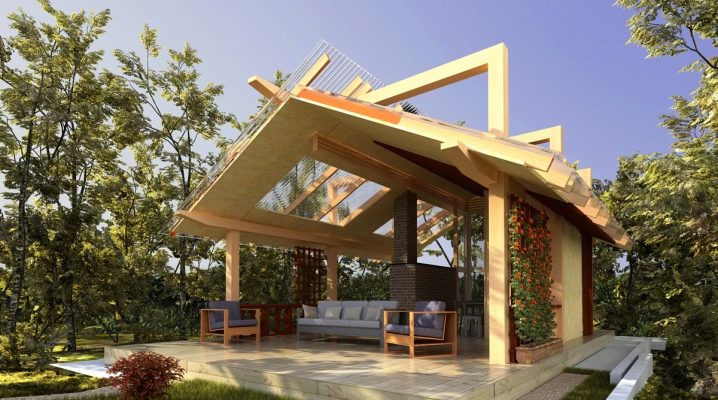
In the warm season, it is much easier to create culinary masterpieces in the summer kitchen. In addition, a free-standing structure will allow you to avoid stuffiness and fumes that accompany frying, cooking and baking in the house. The open space will allow you to cook fish, meat and vegetables on charcoal, barbecue, grill marshmallows with children on the fire and many other things. To build such a kitchen, it is not at all necessary to call hired workers, because you can do everything yourself.
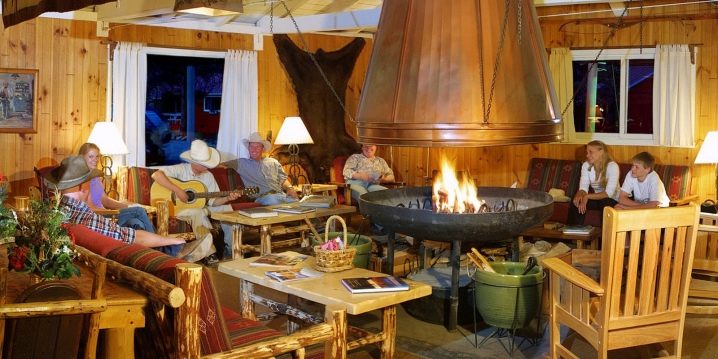
Peculiarities
The design of summer kitchens is open and closed. Both are popular with private home owners. In order to decide which model to build on your site, you need to study the pros and cons of both options. A closed summer kitchen is, in essence, a real home. It has a door, roof, walls, floor and ceiling. There are projects combined with a glazed veranda, a terrace, a cellar, even a bathhouse - there are many options, the limitation is only in the owner's imagination.
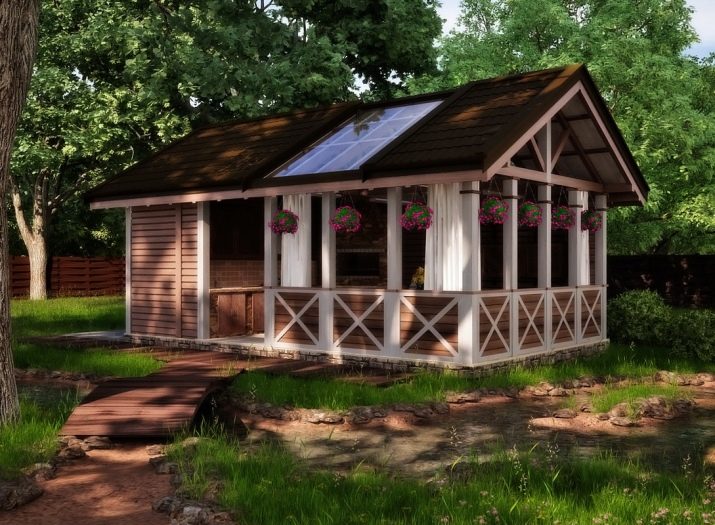
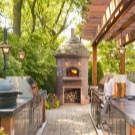
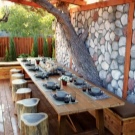
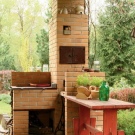

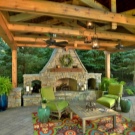
In most cases, for the construction of a summer kitchen, they choose lighter building materials and refuse to insulate the structure, because in the cold season they use the "winter" food block located in the house. But there may be more solid and durable structures made of bricks or foam blocks that can be insulated.
The advantages of the closed type are:
- protection from precipitation, winds, street dirt and insects with rodents;
- the safety of things inside;
- high degree of security.


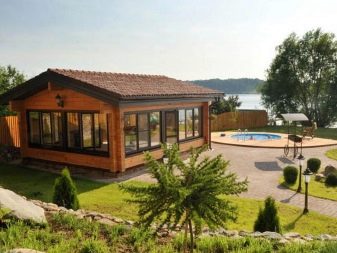

There are also disadvantages:
- more costly and labor-intensive construction;
- additional design and calculations;
- the object must comply with building rules and regulations (permission will be required to put it into operation), but if the rules were not followed, it will not be easy to register ownership of the structure.
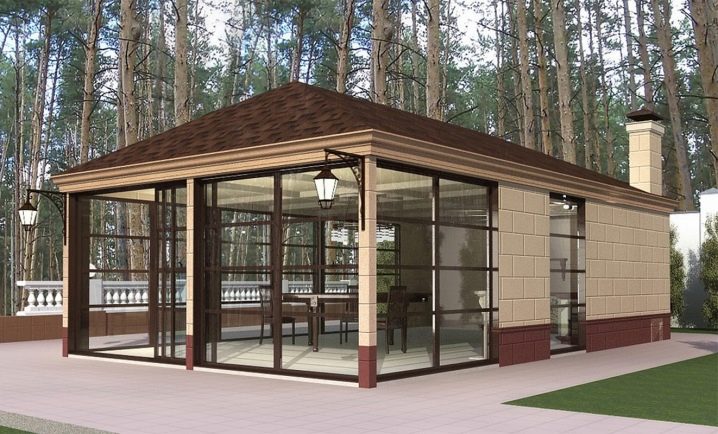
It is inappropriate to build a closed kitchen in the country, which will be empty all winter. But in a country house where the family lives all year round, such structures are extremely in demand.
Open kitchens are structured like a gazebo. The base is made, as a rule, concrete or laid out with tiles. Support pillars are installed on it around the entire perimeter or two walls are erected, and instead of the other two, free space is left. There may be a canopy on top of the structure, or a light roof.

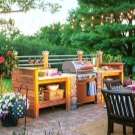
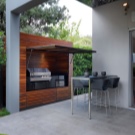

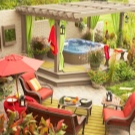

In an open kitchen, it is much easier and safer to install a brazier, barbecue or oven, because the likelihood of fire is much lower. Often, a summer kitchen is connected to a foundation site without walls and a roof.
The structure of such a plan has quite a few advantages:
- fast erection;
- minimum calculations and costs;
- budget project.

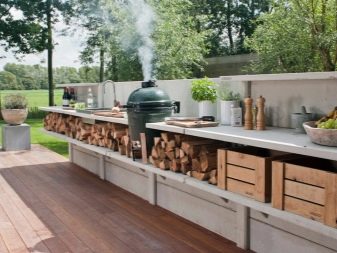
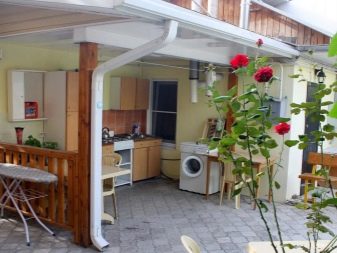
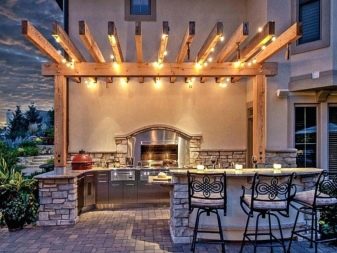
There are also disadvantages:
- does not save from winds, rains;
- does not protect well from insects;
- for the entire cold period of time, you need to clean everything in a closed room.
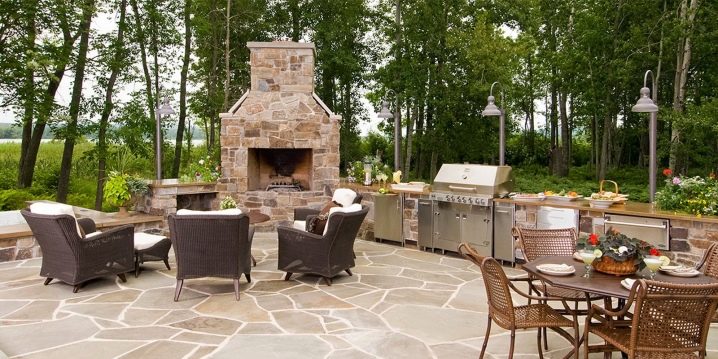
The summer catering unit can be connected to a residential building. It is most convenient for the border to pass from the side of the utility block. The connection can be established as a transition, as well as an ordinary extension with different outputs.
Seat selection
It is necessary to choose a place for a summer kitchen in a garden in such a way that it fits well into the overall landscape composition and does not disturb the location of the beds and flower beds. It is better if it is a free-standing structure in the shade not far from the house. Firstly, it is more convenient to bring all the necessary communications to it.Secondly, if the structure is planned to be open (with a barbecue, barbecue and space for relaxation), then the refrigerator will have to be left in the house. Consequently, the products will need to be brought from there, it is faster to do this when the distance is small.
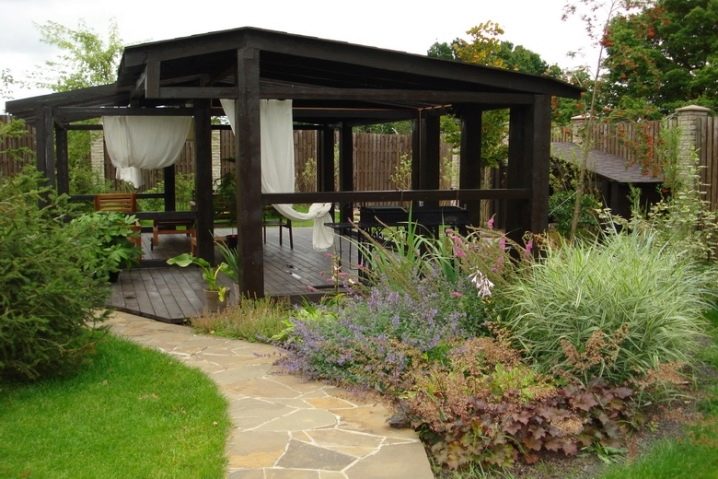
It is safer to position the kitchen so that it is at the back of the site, away from the road. It is equally important to ensure the flow of melt water and sewage, therefore it is advisable to choose a place for the building with a slight slope.
You cannot build a summer kitchen near cesspools, septic tanks and toilets for obvious reasons. It is better to choose the leeward side for its construction, so that all kinds of smells do not bother guests and hosts, and the smoke from the barbecue does not go inside the room.

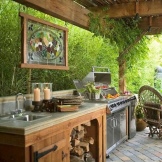
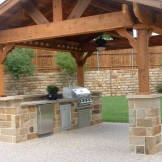
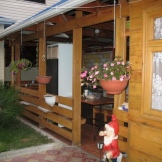
A very simple and convenient design of a summer kitchen is a construction of two solid wooden or brick walls, along which there is a stove or stove, shelves, tables or a table. Instead of the other two walls, there is open space. This is a very practical and functional building, and besides, it can be extraordinarily beautiful, especially if you decorate an open space with trellises and let climbing plants along them.
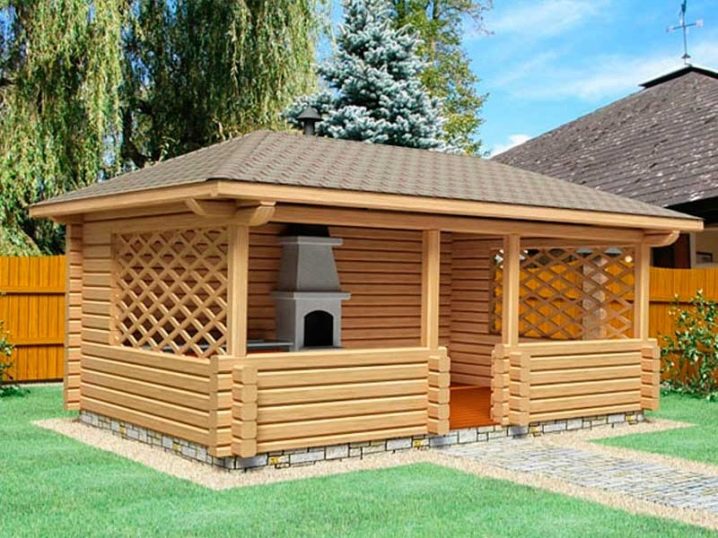
It is not so expensive both in terms of money and materials, and in terms of construction time. When drawing up a construction plan, this will become an obvious fact. For such a structure, you need to choose a place in the shade, but not damp. A low-lying location is also not suitable, as it will attract the attention of insects.

If the summer kitchen is an extension to the house, it is very important that it is completely fireproof, especially if it is planned to install a stove or barbecue there. The fire source should be located as far away from the wall adjacent to the house as possible. As an extension, the summer kitchen is in most cases open. Otherwise, the house will have two rooms that are absolutely identical in functionality and purpose.
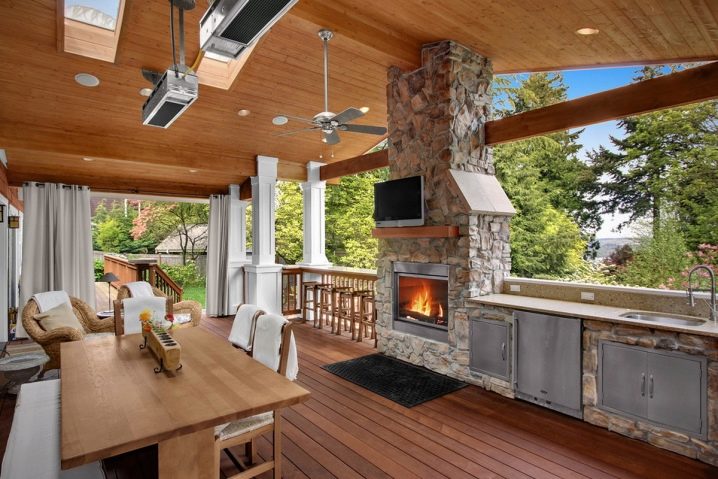
The decision to make the kitchen directly above the cellar can be very successful, because then it will be easy to both get food out of there and put various kinds of blanks there for storage.
Materials (edit)
Summer open-air kitchens are usually constructed from lighter materials and are not insulated.
- The foundation can be made of concrete or sand concrete, cinder block.
- On the base, you can lay boards or lay out tiles. After that, either pillars are installed from a profile pipe made of metal or other material chosen by the owner, or two walls are erected from brick or timber.
- Free space can be decorated with a lattice of boards, or you can leave it open.
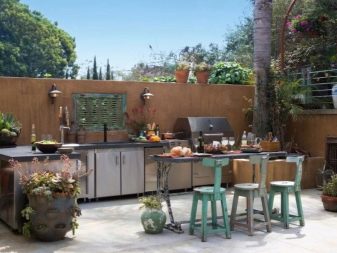
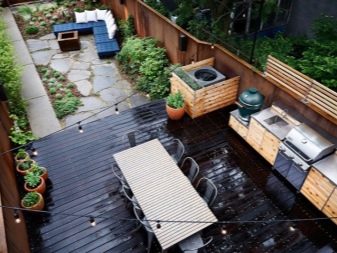
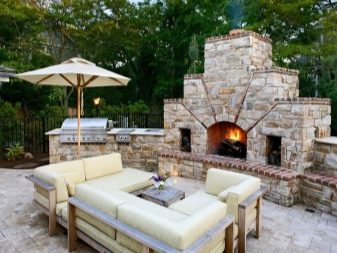
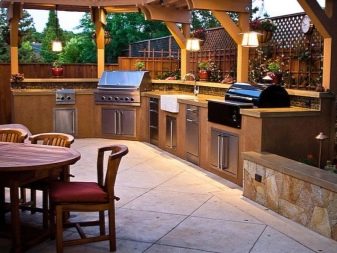
The lightest for the construction of a closed kitchen will be a timber frame structure.installed on a columnar foundation. You can sheathe it with clapboard or OSB plates. Mini-bar cladding is also good. Despite the ease of erecting the frame, finishing can be done of almost any kind: under a bar, plaster, siding. If brick or concrete walls are to be erected, as well as walls made of foam blocks, stone or aerated concrete, it will be necessary to build an additional frame made of metal profiles or wooden slats.
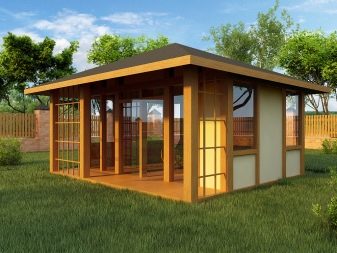
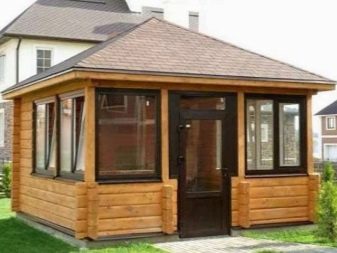
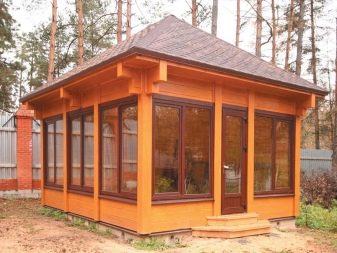
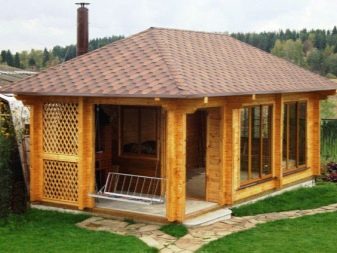
Wooden structures are built from a bar, log or solid wood, but it is important to remember about the weak fire resistance of the material. The tree needs to be impregnated with special compounds from rotting and burning. Brick structures are more durable, fireproof. But they require significant financial and time costs for construction.

Polycarbonate buildings are budget friendly and lightweight. This material transmits the rays of the sun, but has a layer that protects against ultraviolet radiation. It is reliable and durable.
Another inexpensive and lightweight construction material is SIP panels. It is extremely popular among the owners of summer cottages. Consists of chipboard or wooden board outside and polystyrene foam inside.To choose a material for construction, first of all, you need to decide what type of kitchen will be built, how functional it will be, whether the family lives permanently outside the city or comes from time to time. Once all the questions have been answered, the choice will be easy.
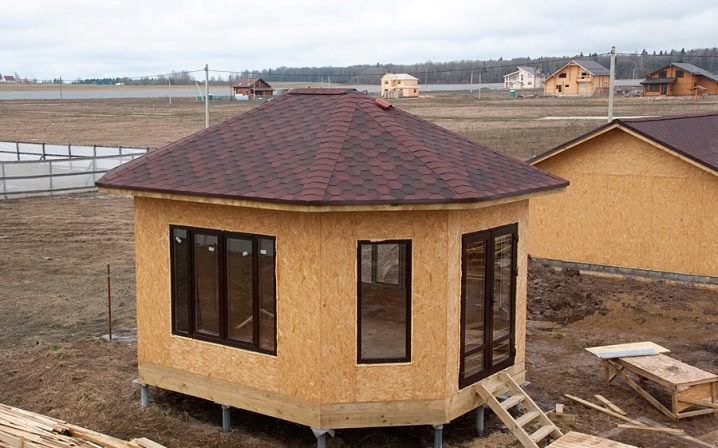
External finishing can be made of the following materials:
- false panels;
- decorative plaster;
- brick;
- wooden boards or slats;
- tile;
- fake diamond.
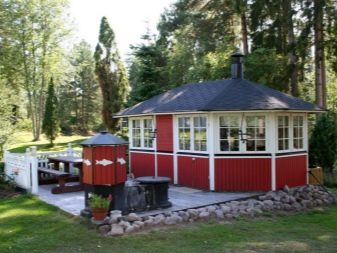

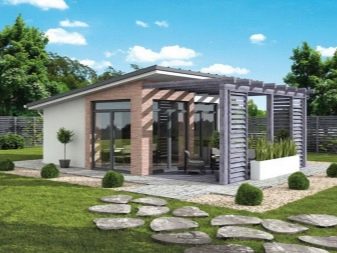
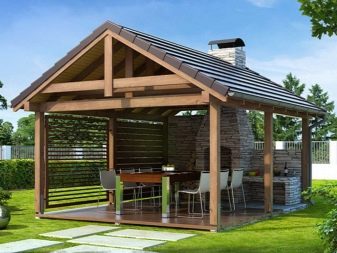
This is not a complete list of what can be used to decorate a summer kitchen.
When choosing a material for interior decoration, you need to proceed from the purpose of the room. In addition to beauty, it should, if possible, resist the ingestion of odors and the formation of fatty deposits; it is good if it can be easily washed and cleaned. Ceramic tiles are most suitable and are ideal for decorating the work area.
If for some reason it is not possible to lay the tiles, there are many more options:
- wallpaper;
- drywall;
- painting walls is the easiest and most affordable way to refresh the kitchen;
- wood;
- plastic panels.
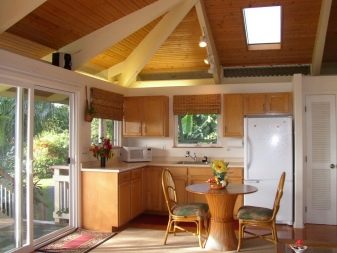
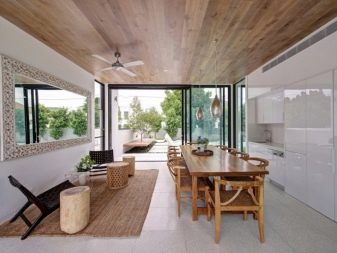

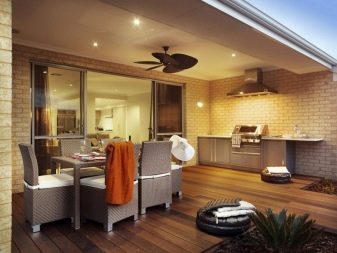
If the summer kitchen is built like a gazebo, that is, it has no walls, part of the space can be filled with a crate. It will be very decorated with climbing or creeping plants - grapes, bindweed. You can also hang thread or voile curtains in the openings - they add air and at the same time block the path of dust. During periods of insect activity, special hermetically sealed curtains will save from their invasion.
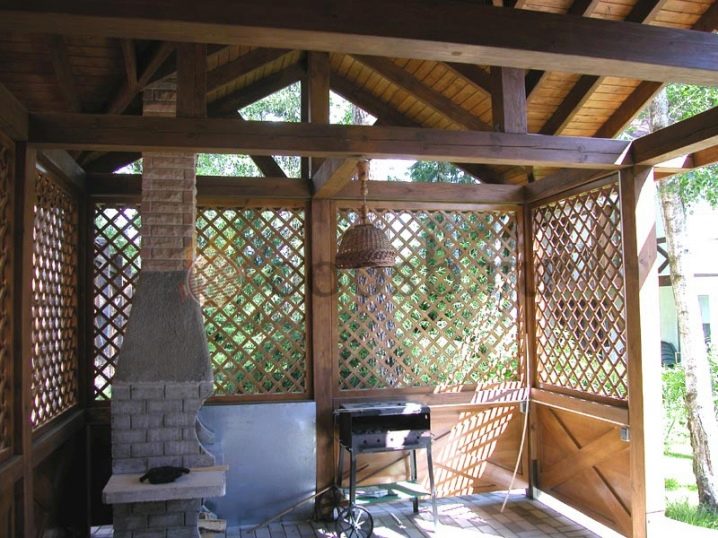
How to build a closed one?
It is not difficult to build a closed summer kitchen with your own hands. Especially if you choose a suitable lightweight material for this - polycarbonate, SIP panels or timber frame construction. If brick construction is planned, it will be much more difficult, since a more solid foundation is required. It will also take longer. It is important to remember that the walls of the future summer kitchen must withstand environmental influences. Therefore, if the climate of the area is rainy and windy, it is better to take care that the covered structure does not leak or leak from precipitation or a blizzard. If the winters are very cold, it is very important to properly insulate the kitchen.
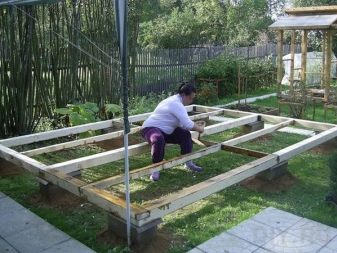

The layout can be any - with a bath, a cellar, a veranda, with a stove or stove. An original solution would be to install a wood-burning fireplace with a hob in the kitchen, if you make it metal, it will be quite cheap. Also, a covered summer kitchen can stand on the same foundation with the house and have a common entrance with it. Or it can be connected to it by a passage or attached to the veranda, and then there will be two entrances. If you assemble the entire frame of the extension from a metal profile, then the walls can be glazed or double-glazed windows installed.
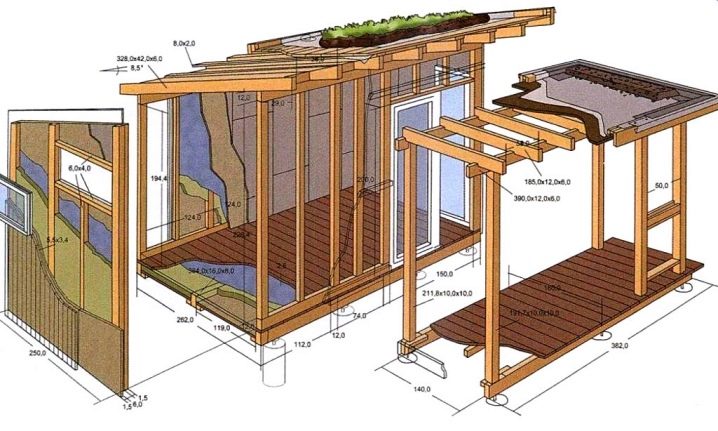
If electricity cannot be supplied to the structure, the problem will be solved by purchasing a diesel generator.
Building a closed kitchen is, in fact, building a house, so the same stages are characteristic of it:
- preparation and pouring of the foundation;
- summing up communications;
- walling;
- roof construction;
- facing if necessary;
- interior decoration.
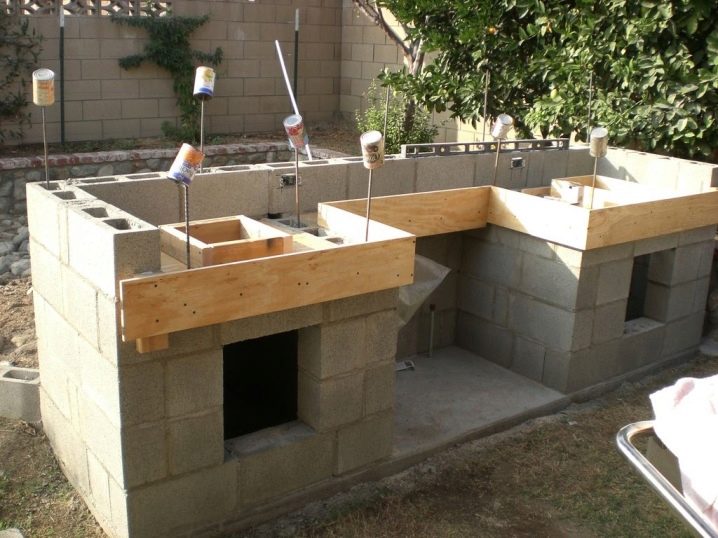
Open construction
An open summer kitchen is even easier and faster to build than a closed one. There is no need for a particularly strong foundation, the floor can be laid as desired. Tiles are preferable for this type of structures, since they are less susceptible to wear and tear and negative effects. The sun shines on the open area, precipitation falls, dust, insects fly, and ceramic tile of all types of floor coverings is the most resistant to all these phenomena.
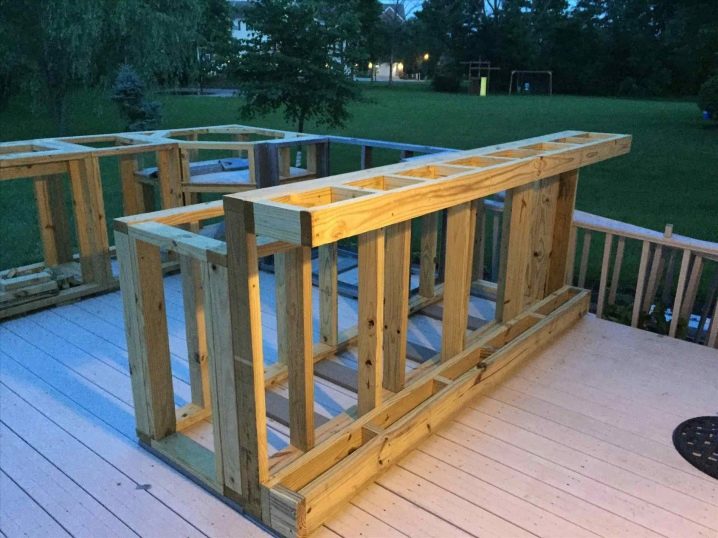
Then comes the stage of mounting load-bearing supports or erecting walls, if such are provided by the drawings. After that, a roof is built (although some projects do without it - a canopy can perform these functions). Further, only interior decoration and arrangement will remain.If you plan to install a brazier or barbecue in the kitchen, it should be large, since both of these devices must be placed at a considerable distance from the dining area. And it would be even more correct - to take the site out for them to the street in order to minimize the risk of burns or fire.
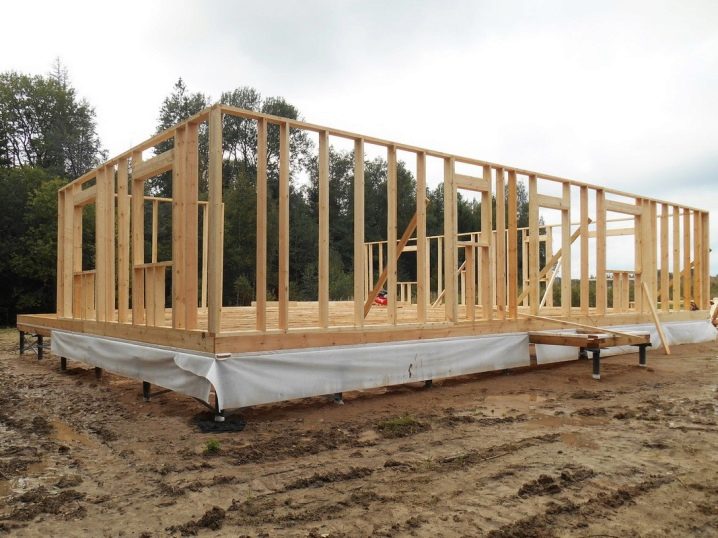
Repair in an open kitchen will have to be done more often, since autumn dampness and winter frosts can make both the roof and walls unusable. In addition, with the onset of the first cold weather, you need to take out everything that can be damaged indoors. You will also have to tighten the openings with dense cellophane or other material that prevents snowdrifts from sweeping inside the structure or from getting wet and premature wear.
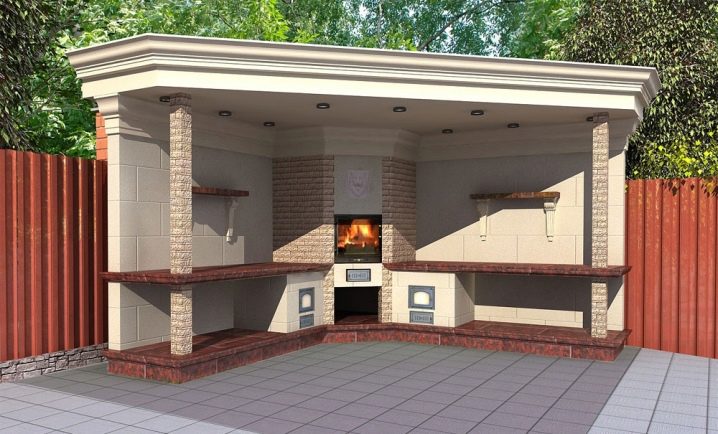
Examples of finished buildings
Open kitchen with two corner walls and pillars attached to the house.
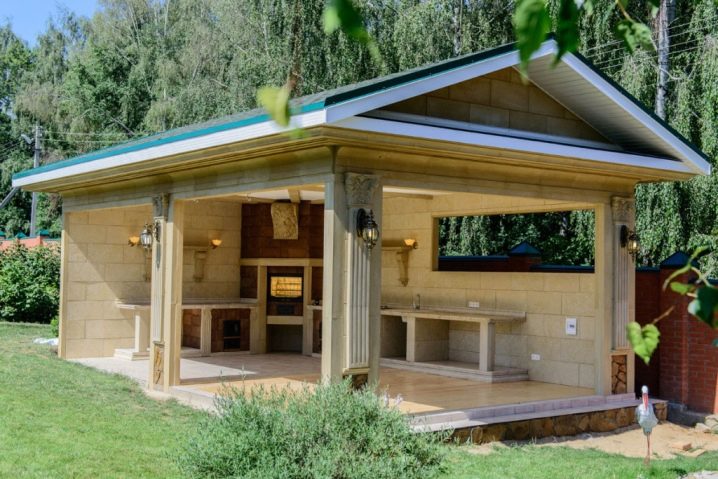
A closed kitchen with full glass walls and a separate barbecue area looks reliable and beautiful.
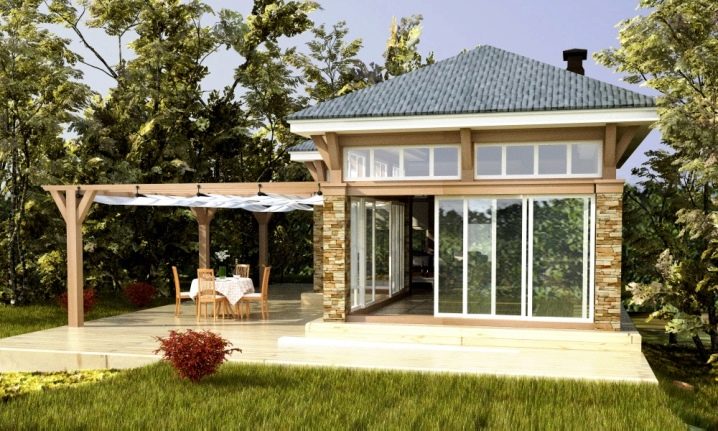
Closed kitchen, finished with wood. Inside view.
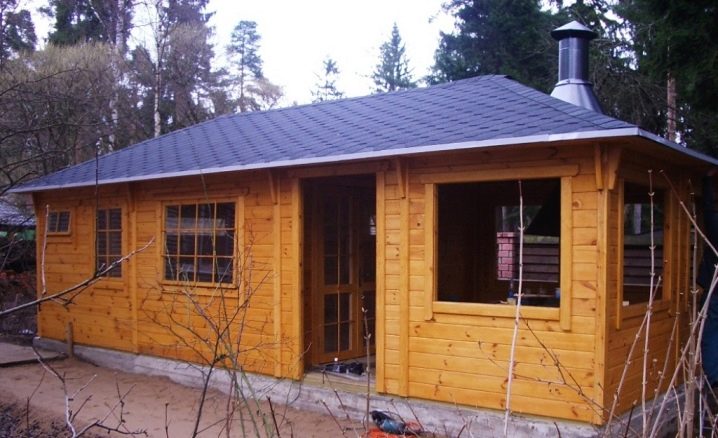
The large open zoned kitchen with a glazed wall is functional and airy.
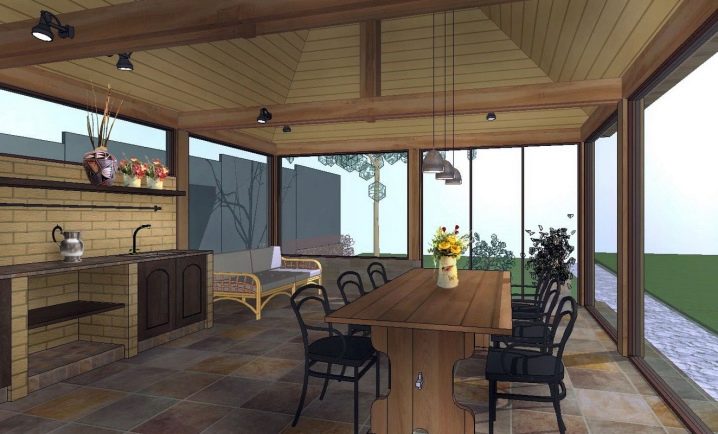
The summer kitchen, attached to the house, is equipped with a gas stove and a brick oven.

An original kitchen with partial wall lathing and stone and wood finishing will decorate any garden area.
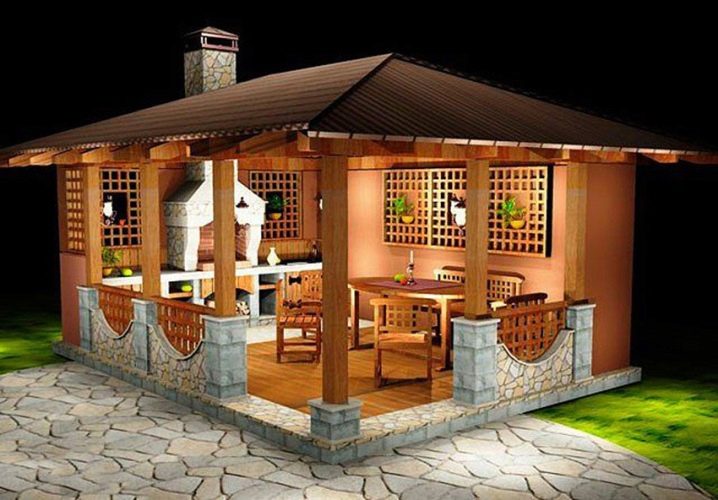
The structure of metal profiles and double-glazed windows looks impressive and modern.
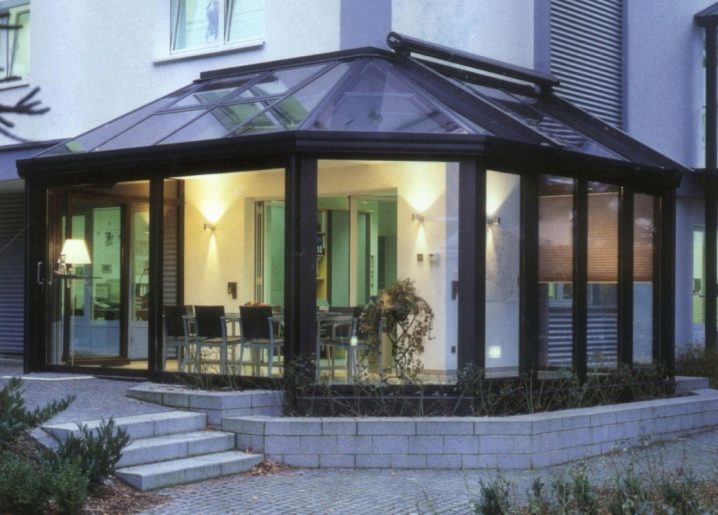
A closed kitchen with a Finnish stove looks like a real home.
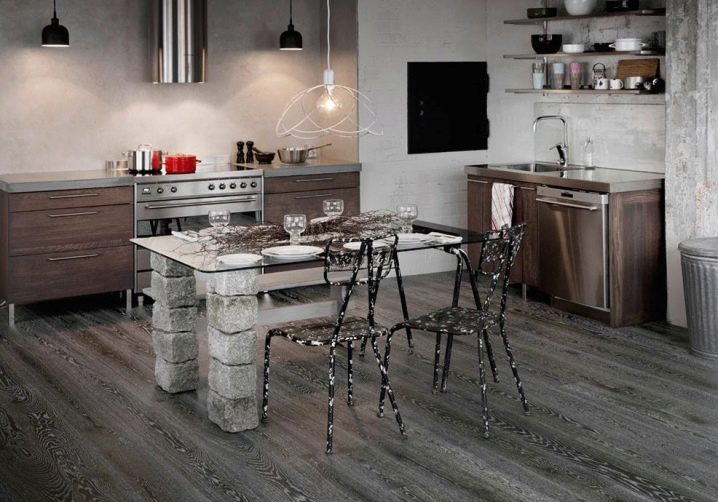
For information on how to build a summer kitchen with your own hands, see the next video.













The comment was sent successfully.